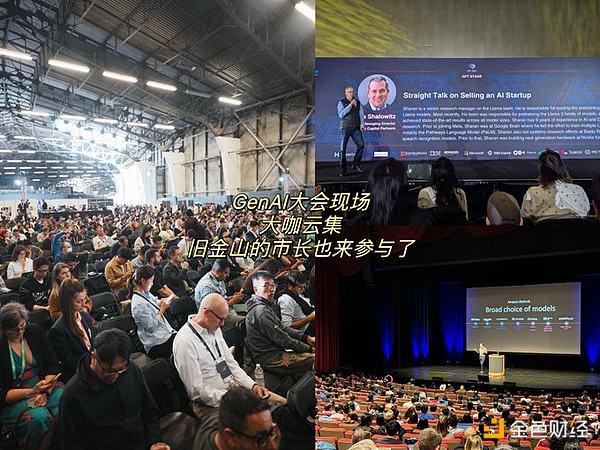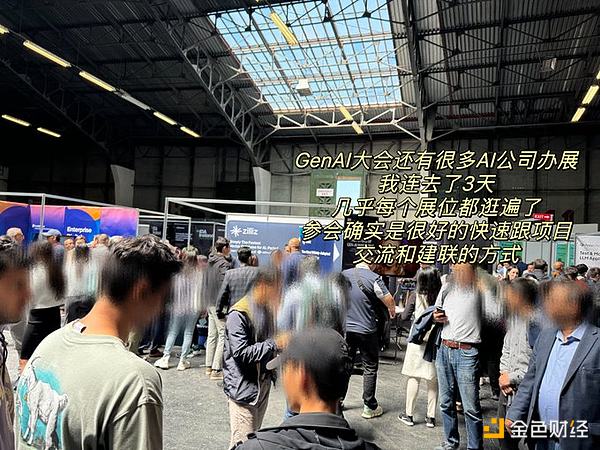Author: Evie Source: X, @0xEvieYang
The market has been terrible these two days, let's take a look at AI to divert attention
The so-called "speculate on the new, not the old", the currency circle has been looking for a new narrative. Since last year, many Web3+AI projects have been launched, and this year there are more than 50 AI projects that have completed financing.
This year, I have also successively purchased popular AI concept tokens such as $WLD and $LPT. However, I have always been curious about the development of mainstream AI? What is the difference between Web3+AI and pure AI? What opportunities are there for Web3+AI?
It is said that "it is difficult for people to make money beyond cognition." In May, San Francisco held a GenAI conference @genaisummitsf with 10,000 participants. I took the opportunity to stay in the United States for a month and visited local AI, investors, entrepreneurs, researchers @FinanceYF5, etc. Next, I will share with you my experiences and thoughts.
Due to limited space, this tweet will focus on the development of the mainstream AI circle, including:
AI investment and financing situation
AI entrepreneurial atmosphere
AI sub-track situation
China-US AI development

AI investment and financing situation
I looked at the projects with more than 50 million US dollars in financing this year and found that most of the projects are 2B, including vertical categories such as health/medical, transportation/driving, finance and finance, as well as tools to improve organizational efficiency; followed by cloud platforms or computing service providers; there are very few 2C applications.
Regarding this issue, my opinion is that the death rate of the C segment is very high at this stage. The existing number of AI users is far from enough to support the cost of C-end applications, and the large amount of high-quality data required for C-end applications is in the hands of large companies, not start-ups. Based on this, some investors even believe that 90% of C-end opportunities are in large companies.
AI entrepreneurial atmosphere
My feeling in the Bay Area is that even breathing is AI-flavored. In the roadshow of the GenAI conference, some projects even started pitching with only a simple idea. It can be seen that the entrepreneurial market is still relatively tolerant of this field, which is a bit like the feeling of "mass entrepreneurship and innovation" in the past.
However, if you really want to stand out from the many AI projects, it is much more competitive than you think, and you still have to compare technology, background, and resources. The current star AI projects have teams with the background of top North American universities + large companies, or they are serial successful entrepreneurs.
As far as the organizational structure of the project is concerned, one feature I have observed is "inverted pyramid" - that is, there are more high-quality and high-level members at the top, but fewer junior engineers.

Development of AI sub-tracks
Computing power: There is a huge demand for Nvidia in the market now, but the supply is very limited, and large companies also have to fight for GPUs. The competition among large model companies is now a cruel money competition. More capital is needed to buy more cards and snatch more talents. In addition to the supply and demand of GPUs, reducing energy consumption is also a problem that needs to be solved.
Data: The development of large models requires powerful GPUs, but at the same time, data as another key resource is also gaining more and more attention. Therefore, some top AI labs are now competing for more valuable data. They will spend a lot of money to buy data, find experts to generate data, or work with companies like Scale AI to label data.
Some researchers predict that high-quality data will run out in 2026. Therefore, the importance of synthetic data is increasing. In 2024, it is expected that 60% of the data used to train AI will be synthetic data.
Model: Regarding the question of which is better, open source or closed source models, I have heard different opinions. Some investors are very optimistic about open source and believe that open source can attract contributors to participate. Whether it is a large company or a startup, a lower-cost model may appear under the open source model. At present, some models have reached the level of ChatGPT 4. Another view is that most of the open source models have not been verified by computing power, and the market will not buy them. It is definitely more supportive of closed source talents and resources.
Based on the logic of open source, if a Web3 business model is embedded, then everyone can contribute to a model and share the model benefits based on the degree of contribution. There are projects doing similar things now, but whether it is feasible or not is not discussed here.
In addition, most relatively mature models are supported by cloud service companies. For example, in the latest round of $1 billion financing of Dark Side of the Moon, Alibaba led the investment, and part of the investment was in computing power.
Enterprise software service companies like Salseforece also have their own AI teams of hundreds of people, and their AI directly serves their own products.
Application: Chatbot is a must-win for large companies. There are relatively few large companies in the search field, mainly Microsoft, and NewBing is currently in a basically monopolistic position.
Although Apple's stock price fell after it announced its AI plans at this year's Developer Conference, I personally look forward to the combination of Apple and AI. After all, Apple is the most commonly used electronic device in daily life, and it has its own models, chips, cloud, and massive data. These form an ecosystem. If each link is optimized a little, the superposition will be very strong.

Sino-US AI Development
As for the development of AI in the United States, innovation is still in the Bay Area. The amount of venture capital received by AI startups in Silicon Valley is much higher than that in other regions. AI in New York mainly focuses on landing applications, and some companies are using AI to replace or assist the work of paralegals.
I met a friend who does AI consulting services in New York. They are helping some traditional companies to develop AI system solutions. The integration of AI and enterprise workflow is irreversible. I feel that in a few years, juniors in consulting, auditing, and legal professions will face considerable pressure to lay off employees.
Big models are mainly concentrated in the United States, followed by China and Europe; the number of big models released in the United States last year was 3 to 4 times that of China. The domestic big model, Dark Side of the Moon, announced this year that it had raised $1 billion. Tencent, Alibaba and other large companies have also joined the game, which can be regarded as "the whole country's strength" to support its own big model.
 Weiliang
Weiliang





